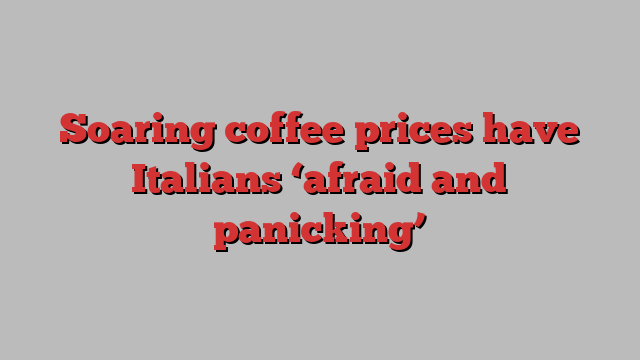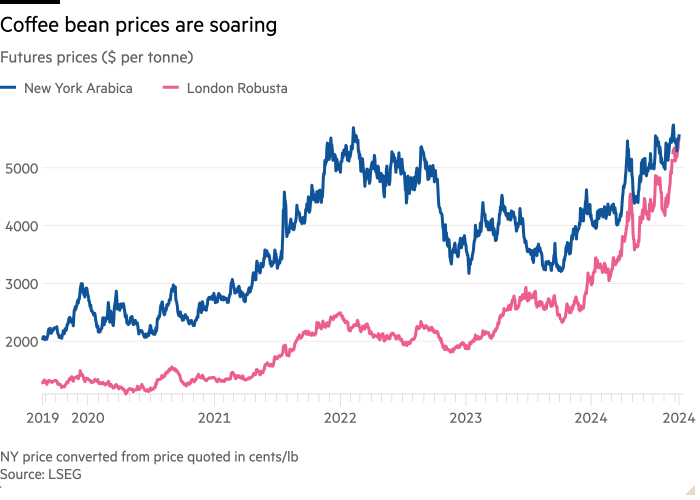
Italians are in a froth over the future of their cheap espressos as global coffee bean prices surge.
Long accustomed to ultra-affordable shots — prices were once even regulated by the state — Italians are growing restive at prices set to increase by as much as two-thirds.
“Everybody is quite nervous, afraid and panicking about the price of espresso,” said Luigi Morello, president of the Italian Espresso Institute, which certifies quality.
Italians drink some of western Europe’s least expensive coffee, paying about €1.20 for an espresso or €1.50 for a cappuccino, in the country’s ubiquitous and convivial coffee bars.
Low coffee prices have driven a heavy caffeine habit, with influential consumer association Assoutenti estimating Italians and foreign tourists consume 6bn coffees a year at public establishments, generating revenues of about €7bn.
But disruptions in global coffee supply caused by climate change could force Italians to pay up to €2 per shot of their daily fix: still charmingly cheap for Londoners or New Yorkers but a shock for Romans.
Consumer groups are up in arms, with Assoutenti noting Italy’s espresso prices have risen about 15 per cent since 2021, as baristas confront surging energy costs and other pressures.
Assoutenti president Gabriele Melluso lamented that any further increase in prices at the local café would threaten “a daily ritual for millions of citizens”, pushing those who acquired coffee machines during the Covid-19 pandemic to drink it at home.
“If the price of coffee rises further, a portion of the population might completely forgo espresso at the bar,” Melluso said.
However, associations representing baristas warn further price increases are inevitable, especially for traditional coffee bars, where sales of espresso and other coffee concoctions typically account for as much 30 per cent of sales.
Global coffee prices have soared to record highs recently as a result of poor weather in the world’s main growing regions.
Futures prices for higher-end arabica coffee traded in New York climbed to $2.49 per pound this week, while prices for robusta beans in London topped $5,000 per tonne, double the prices a year ago.
Supply chains are also facing disruption from Houthi militants’ attacks on ships in the Red Sea. Since November, vessels moving between Asia and Europe have been forced to travel the much longer route around the Cape of Good Hope instead of through the Suez Canal.

Roasters have raised their prices. Further increases are likely to follow, Giuseppe Lavazza, chair of Lavazza Group, told the Financial Times in July, a warning echoed by Cristina Scocchia, chief executive of Illycaffè, at a large public forum last month.
Yet despite this rise in coffee prices, Melluso insisted that for Italy’s coffee bars “the production cost of a cup is significantly lower than the selling price, and profit margins continue”.
Morello and others representing the sector disagree.
“Dedicated coffee bars are in trouble,” said Luciano Sbraga, deputy president of the Federation of Italian Public Establishments, which represents many of Italy’s estimated 132,000 coffee bars.
“They can only work if they are run by families, with no employees, and no expensive locations. Then you can keep yourself alive.”
Historically, Rome regulated the price of espresso to keep it affordable for all and though price controls ended decades ago, customers have become accustomed to cheap coffee.
“There is an expectation among the people to have a fixed price, which is a political price,” Morello said. “From the other side, baristas are afraid to increase too much, so as not to lose the volume.”
Sbraga said baristas — deeply embedded in the communities they serve — also face social pressures to maintain low espresso prices, though they may charge more for elaborate drinks such as cappuccinos and for snacks.
“A product like an espresso is a necessity — like bread,” he said. “When customers have the perception of such an importance of the product, it is not easy to raise the prices.”
In Liguria, one bar owner responded to customer complaints about the price by offering to sell espresso for just 70 cents if they brought their own cups, spoons and sugar from home.
Gianni Manganiello, 54, now runs the Tazza D’Oro coffee shop that his father started 70 years ago in the working-class district of Centocelle in Rome. He currently sells espresso for €1 per cup, after a post-pandemic price increase from the previous rate of 90 cents.
But he said he would be willing to raise espresso prices by another 10 per cent if raw material prices surge. “You can’t increase every price or all the customers disappear,” he said. “You have to maintain a balance.”
Additional reporting by Giuliana Ricozzi in Rome